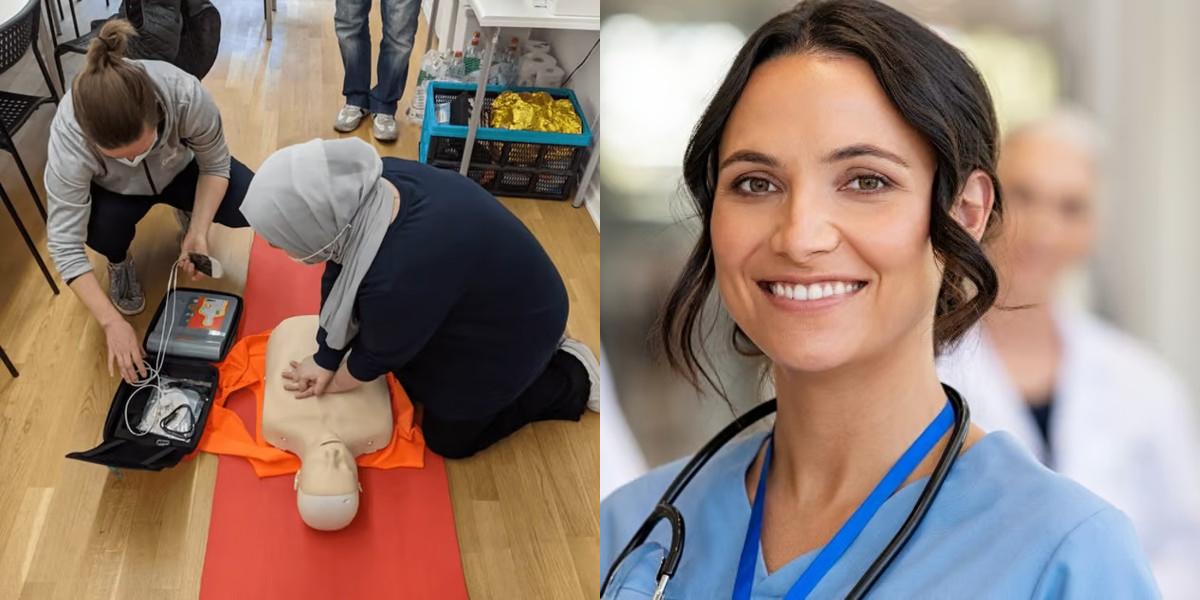CPR-BLS vs Graduate Nursing
SearchCPR / Basic Life Support
classes near 43215

Key Points:
- CPR-BLS providers focus on emergency life-saving techniques; Graduate Nurses have a broader range of clinical duties.
- CPR-BLS providers typically earn less than Graduate Nurses, with the latter often commanding higher salaries due to their advanced education and clinical expertise.
- Both fields have job opportunities.
- CPR-BLS training is often completed through in-person courses, while Graduate Nursing programs require a mix of online and in-person instruction.
- CPR-BLS training is generally less expensive and shorter in duration compared to a Graduate Nursing degree.
CPR-BLS, which stands for Cardiopulmonary Resuscitation - Basic Life Support, is a certification that healthcare professionals must obtain to provide emergency care to individuals experiencing cardiac arrest or other life-threatening conditions. On the other hand, graduate nursing is an advanced degree program that prepares individuals to become registered nurses or pursue specialized roles in nursing practice, education, or research.
What is CPR-BLS?
CPR-BLS is a technique used to save the lives of individuals who are experiencing a cardiac arrest or other life-threatening emergencies. It involves performing chest compressions and providing rescue breaths to maintain blood flow and oxygenation until professional medical help arrives. CPR-BLS certification is typically required for healthcare professionals such as nurses, doctors, and paramedics, as well as individuals who work in certain industries like childcare or lifeguarding.
What is Graduate Nursing?
Graduate nursing refers to advanced education and training programs that prepare individuals to become registered nurses or pursue specialized roles in nursing practice, education, or research. These programs are typically offered at the master's or doctoral level and can lead to advanced practice nursing roles such as nurse practitioners, nurse anesthetists, nurse midwives, or nurse educators. Graduate nursing programs provide students with a strong foundation in nursing theory, research, leadership, and clinical skills.
Difference between CPR-BLS and Graduate Nursing
While both CPR-BLS and graduate nursing involve caring for patients and ensuring their well-being, there are some key differences between the two:
-
Scope of practice: CPR-BLS providers are trained to respond to emergencies and provide immediate life-saving care. Their scope of practice is limited to emergency situations and does not involve ongoing patient care. On the other hand, graduate nurses have a broader scope of practice and are trained to provide comprehensive care to patients across the lifespan in various healthcare settings.
-
Level of education: CPR-BLS certification typically requires completion of a short training course, which can range from a few hours to a few days. This training focuses on the basic skills needed to perform CPR and respond to emergencies. In contrast, graduate nursing programs require completion of a bachelor's degree in nursing (BSN) as a minimum entry requirement. Many programs also require applicants to have a few years of nursing experience. Graduate nursing programs typically take 2-3 years to complete and include coursework, clinical rotations, and research projects.
-
Responsibilities and autonomy: CPR-BLS providers are often part of a larger healthcare team and work under the supervision of a healthcare professional with a higher level of training, such as a nurse or doctor. They are responsible for responding to emergencies and providing immediate life-saving care until professional medical help arrives. Graduate nurses, on the other hand, have more responsibilities and autonomy in patient care. They are qualified to assess, diagnose, and treat patients independently, and may even have prescriptive authority depending on their role and state regulations.
CPR-BLS vs Graduate Nursing: Job Description
-
CPR-BLS: CPR-BLS providers play a crucial role in emergency situations. Their job is to respond quickly to cardiac arrests or other life-threatening emergencies and provide immediate life-saving care. They must be able to assess the situation, perform CPR, use automated external defibrillators (AEDs), and provide basic first aid until professional medical help arrives. CPR-BLS providers work in a variety of settings, including hospitals, clinics, schools, and public places.
-
Graduate Nursing: Graduate nurses have a wider range of job opportunities. They can work in hospitals, clinics, private practices, schools, research institutions, and other healthcare settings. Depending on their specialization, they may provide primary care, acute care, or specialized care to patients across the lifespan. Graduate nurses may also work as nurse educators, nurse researchers, or nurse leaders, depending on their career goals and interests.
Get courses selected just for you
Try our powerful search engine
CPR-BLS vs Graduate Nursing: Education and Training
-
CPR-BLS: CPR-BLS certification can be obtained through a short training course, which covers the basic skills needed to respond to emergencies and provide immediate life-saving care. These courses typically include hands-on practice with mannequins and AEDs, as well as written exams to assess knowledge and skills. CPR-BLS certifications are valid for a certain period of time, usually 2-3 years, and must be renewed through additional training and testing.
-
Graduate Nursing: To become a graduate nurse, individuals must first complete a bachelor's degree in nursing (BSN). After obtaining their BSN, they can apply to graduate nursing programs, which are typically offered at the master's or doctoral level. These programs include coursework in advanced nursing theory, research, leadership, and clinical skills, as well as supervised clinical rotations in various healthcare settings. Upon completion of their graduate nursing program, individuals are eligible to sit for the national certification exam in their chosen specialty, such as family nurse practitioner or nurse midwife.
CPR-BLS vs Graduate Nursing: Career Outlook and Salary
-
CPR-BLS: CPR-BLS providers are in high demand in healthcare settings and other industries that require emergency response teams. The demand for CPR-BLS certification is expected to continue to grow as more organizations recognize the importance of having trained individuals on-site to respond to emergencies. The salary for CPR-BLS providers varies depending on factors such as experience, location, and the specific industry they work in. According to the U.S. Bureau of Labor Statistics, the median annual wage for emergency medical technicians (EMTs) and paramedics, who often have CPR-BLS certification, was $35,400 in May 2020.
-
Graduate Nursing: The career outlook for graduate nurses is also promising, as the demand for advanced practice nurses continues to grow. According to the American Association of Nurse Practitioners, the number of nurse practitioners in the United States has more than doubled over the past decade. The salary for graduate nurses varies depending on factors such as specialization, experience, location, and the specific healthcare setting they work in. According to the U.S. Bureau of Labor Statistics, the median annual wage for nurse practitioners, who are graduate-level nurses, was $117,670 in May 2020.
Final Thoughts
Choosing between CPR-BLS and graduate nursing ultimately depends on your career goals, interests, and the level of responsibility you wish to have in patient care. If you are interested in providing immediate life-saving care in emergency situations, CPR-BLS may be a good fit for you. On the other hand, if you aspire to provide comprehensive care to patients across the lifespan and have a greater level of autonomy in patient care, graduate nursing may be the right path for you. It's important to carefully consider your options, research the requirements and job prospects for each role, and speak with professionals in the field to make an informed decision about your career in healthcare.
Dreambound's program is accessible in diverse locations. Take a deep dive into these blogs for comprehensive insights into the two vocations, covering their requirements and guidance on joining:

Alyssa Jane is part of the customer success team at Dreambound. She works with students, training providers, and employers, helping them have a smooth customer journey. She is also an ESL tutor and Licensed Psychometrician. She is fond of traveling, photography, and discovering new restaurants.
